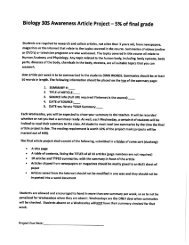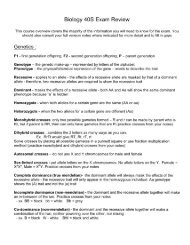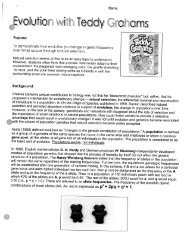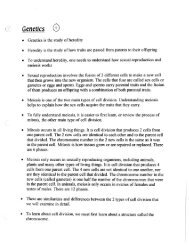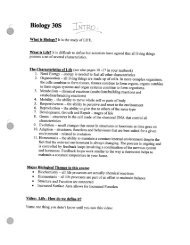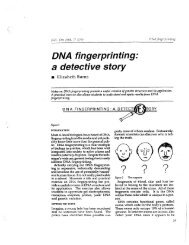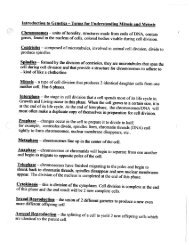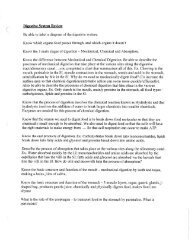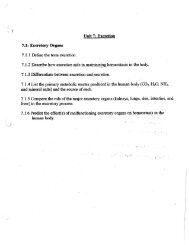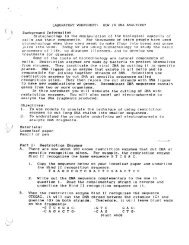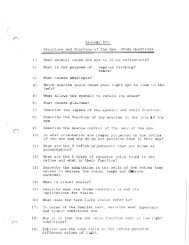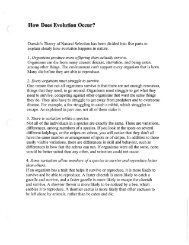The Roles of the Nephron of the 120 ml of blood that is ... - Mrs Stovel
The Roles of the Nephron of the 120 ml of blood that is ... - Mrs Stovel
The Roles of the Nephron of the 120 ml of blood that is ... - Mrs Stovel
- No tags were found...
Create successful ePaper yourself
Turn your PDF publications into a flip-book with our unique Google optimized e-Paper software.
<strong>The</strong> Counter Current Mechan<strong>is</strong>m <strong>of</strong> <strong>the</strong><strong>Nephron</strong><strong>The</strong> loop <strong>of</strong> Henle works toward <strong>the</strong>goal <strong>of</strong> water conservation. Animals <strong>that</strong> livein a terrestrial environment need to be carefulnot to waste water. It <strong>is</strong> clearly a waste,if water<strong>is</strong> in short supply, to release too much waterwith <strong>the</strong> urine. As a result <strong>the</strong>re needs to be amechan<strong>is</strong>m to encourage water out <strong>of</strong> <strong>the</strong> urineand back into <strong>the</strong> <strong>blood</strong>. <strong>The</strong> loop <strong>of</strong> Henlecreates <strong>that</strong> mechan<strong>is</strong>m in terrestrialanimals.<strong>The</strong>re <strong>is</strong> no way <strong>of</strong> actively capturingwater in <strong>the</strong> urine <strong>that</strong> <strong>is</strong> passing through <strong>the</strong>collecting ducts. It would almost seem too lateto capture <strong>the</strong> water <strong>that</strong> <strong>is</strong> already on its wayout <strong>of</strong> <strong>the</strong> body. However, <strong>the</strong> nifty nephroncreates a trick with its loop <strong>of</strong> lienle to get <strong>the</strong>water out <strong>of</strong> <strong>the</strong> collecting duct before it leaves<strong>the</strong> kidney, It does so by creating a saltyenvironment in <strong>the</strong> medulla area <strong>of</strong> <strong>the</strong>kidney.<strong>The</strong> ascending loop <strong>of</strong> Henle activelytransports chlorine ions out <strong>of</strong> <strong>the</strong> filtrate withcarrier proteins. Chlorine builds up in <strong>the</strong>fluids <strong>of</strong> <strong>the</strong> medulla by active transport.Because it <strong>is</strong> a negative ion, it creates a causefor <strong>the</strong> sodium ion, which <strong>is</strong> positive, to rush out<strong>of</strong> <strong>the</strong> loop after chlorine. <strong>The</strong> sodium rushesout by diffusion because <strong>of</strong> its 'fatal attraction'to chlorine. <strong>The</strong> chlorine and <strong>the</strong> sodium ionscollect and dominate <strong>the</strong> fluids outside <strong>the</strong> loop<strong>of</strong> I-fenle creating a salty environment. Th<strong>is</strong>salty environment catches <strong>the</strong> attention <strong>of</strong> <strong>the</strong>water <strong>that</strong> <strong>is</strong> passing through <strong>the</strong> nearbycollecting duct. <strong>The</strong> collecting duct <strong>is</strong>permeable to water but not permeable to <strong>the</strong>salt. Water can. not res<strong>is</strong>t moving into <strong>the</strong>salty medulla. <strong>The</strong> salt creates an osmoticpressure <strong>that</strong> pulls <strong>the</strong> water out <strong>of</strong> <strong>the</strong> collectingduct by osmos<strong>is</strong>. (Water has a 'fatal attraction'to salty solutions.) Once <strong>the</strong> water <strong>is</strong> out <strong>of</strong> <strong>the</strong>duct it <strong>is</strong> no longer destined for elimination butcan' now be picked up by <strong>the</strong> nearby. ,Moodcapillaries and returned to be used by;.bodysystems.Meanwhile, back at <strong>the</strong> loop <strong>of</strong>`-•Henle,trouble <strong>is</strong> starting. <strong>The</strong> ascending loop <strong>is</strong>running out <strong>of</strong> salt. <strong>The</strong>re <strong>is</strong> no need to worry.<strong>The</strong> salt trick can continue because <strong>the</strong>descending loop in its w<strong>is</strong>dom <strong>is</strong> stealing back<strong>the</strong> salt <strong>that</strong> <strong>the</strong> ascending loop <strong>is</strong> so generouslyreleasing. Th<strong>is</strong> helps to keep a constant flow <strong>of</strong>salt inside <strong>the</strong> loop for <strong>the</strong> ascending lope topump out . Because <strong>of</strong> <strong>the</strong> generosity gf<strong>the</strong>ascending loop and <strong>the</strong> stinginess <strong>of</strong> <strong>the</strong>descending loop a salt trade or salt current <strong>is</strong>establ<strong>is</strong>hed as <strong>the</strong> salt moves ouc <strong>of</strong> <strong>the</strong>ascen ding loop and into <strong>the</strong> descending loop,Th<strong>is</strong> salt current establ<strong>is</strong>hed by <strong>the</strong> loop <strong>of</strong>lienle maintains an environment <strong>that</strong> attractswater out <strong>of</strong> <strong>the</strong> ducts containing urine andback into <strong>the</strong> <strong>blood</strong>. Th<strong>is</strong> process <strong>is</strong> called <strong>the</strong>counter current mechan<strong>is</strong>m.



